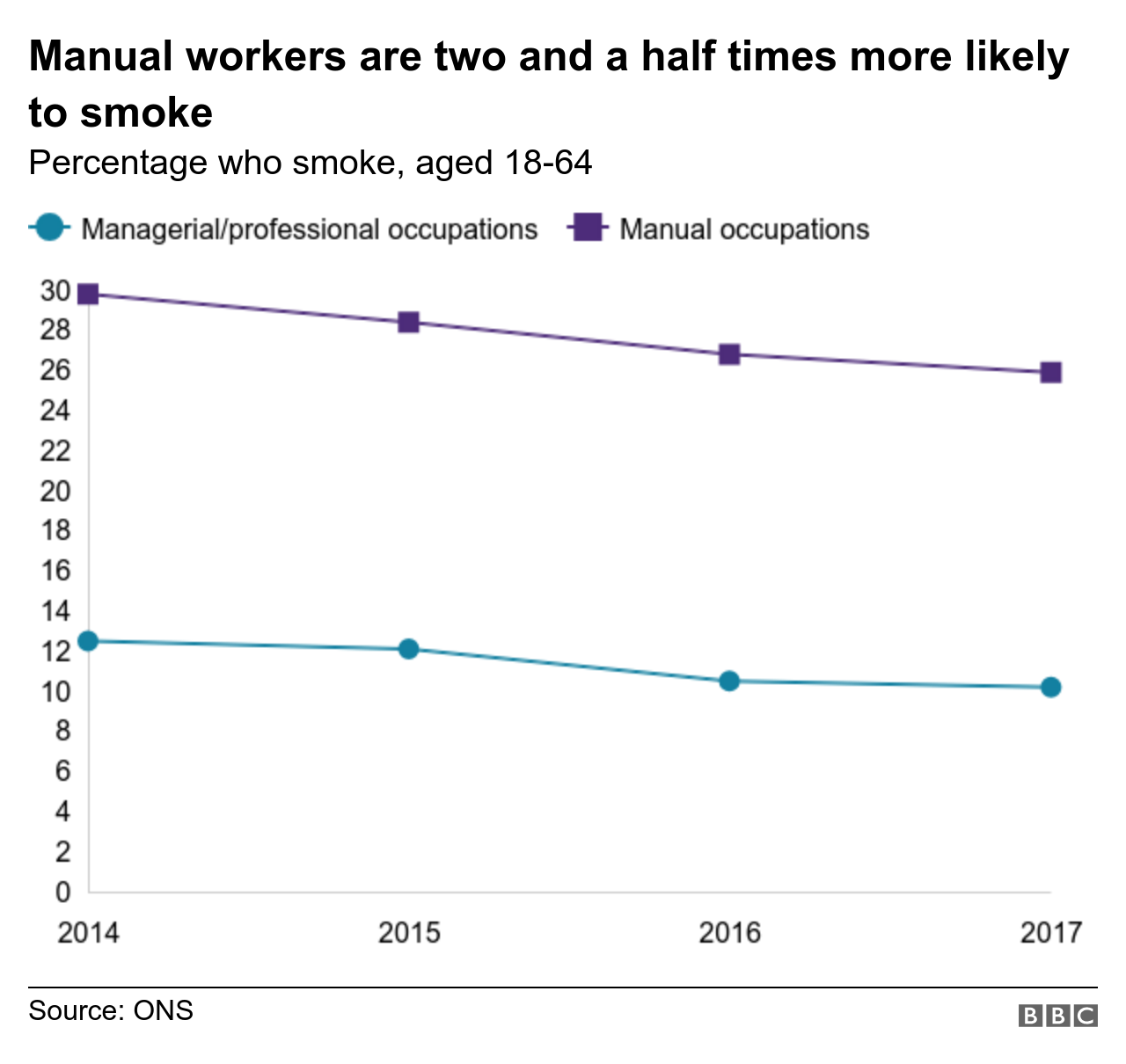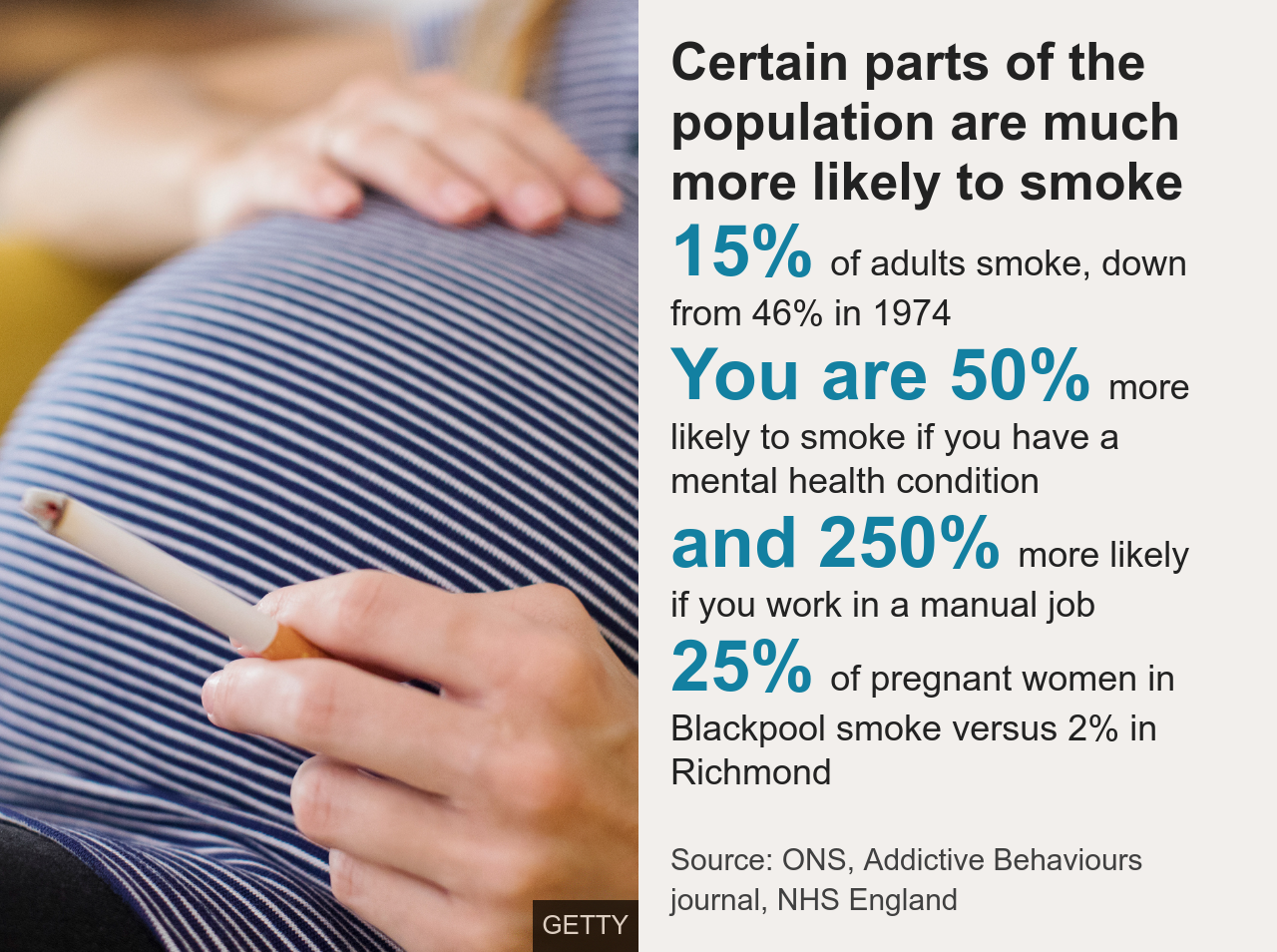Who are the smokers that haven't quit?
- Published

In 1974, almost half of all adults in the UK smoked. For many, spending time in smoke-filled homes, pubs and workplaces was simply a part of daily life.
Today, that figure has fallen to 15%. The government has pledged to end smoking in England altogether by 2030.
But some people remain much more likely to smoke than others.
People living on a low income are disproportionately likely to smoke, for example. One in three social housing residents, external and one in four manual workers, external smokes, compared with one in 10 of those in professional or managerial jobs.

Smoking rates also differ considerably around the country, external. Only 8.6% of those in East Devon smoke, for example, compared with 21.8% in Dundee.
This regional divide is startlingly illustrated by the proportion of women who smoke while pregnant.
In England, one in 10 pregnant women smoke. But within this there are huge variations - ranging from one in 50 in some wealthy parts of London to one in four in Blackpool, one of the most deprived areas, external.
People with mental health problems are similarly affected. This group is 50% more likely to smoke than the rest of the population, external, a gap that has been widening.
Because smoking is so uniquely harmful, this translates into major differences in illness and early death.
One US study suggested smoking accounted for two-thirds of the life expectancy shortfall among people with mental health problems, external, 10 years of lost life. These findings are likely to apply to other countries too.
Another study indicated the poorest men in England and Wales were twice as likely to die between the ages of 35 and 69 as the richest - and their death was almost five times more likely to be caused by smoking, external.

Why are these groups more at risk?
In recent years, the UK has introduced policies that appear to have helped many smokers quit and deterred others from starting.
The smoking ban was introduced in 2007, alongside a raising of the minimum purchasing age to 18.
Taxes on a £10 pack of 20 cigarettes have increased to over 80% of the retail price, external, while the packaging and display of tobacco products have become increasingly restricted and advertising banned.
Wales is targeting a 16% smoking rate by 2020, while the Scottish government aims to create a "tobacco-free" generation by 2034 and Northern Ireland is also aiming to eradicate smoking altogether, in addition to England's pledge to end smoking by 2030.
Stop-smoking services providing support and medication have also been offered nationwide, contributing to the fall in overall smoking rates.
Yet they have been less effective for poorer, external and mentally ill, external smokers, even if they are as likely to try to quit as other groups, external.

Public Health England suggests e-cigarettes may contribute to tens of thousands of successful additional quit attempts every year
The reasons for this are varied and complex.
These groups can have higher levels of dependence, external, making it harder to give up, external. They are also more likely to be around other smokers, normalising the behaviour and making it harder to quit successfully.
They may also have to deal with stress factors such as income instability, poor housing and living in run‐down neighbourhoods.
At the same time, stop-smoking services, which appear to have helped reduce inequalities, external, have disappeared in many areas, with an estimated 30% funding cut in England between 2014-15 and 2017-18 , external.
Financial incentives
For these reasons, a different approach may be needed.
Some clear recommendations have been made, external to stop the third of mentally ill people who smoke from being left behind. Many can be applied to other at-risk groups.
Free, tailored individual support, including advice, mobile stop-smoking services and online resources, external, has been shown to be effective, as have financial incentives such as making cigarettes more expensive and offering smokers cash to quit.
Price increases appear to work best in combination with support such as counselling and smoking alternatives such as electronic cigarettes or nicotine patches.
E-cigarettes, in particular, have become more popular in recent years. Public Health England suggests these products carry a fraction of smoking's risk and every year could be contributing to between 22,000 and 57,000 people quitting smoking, external.
Doctors asking patients if they smoke could also help identify would-be quitters who don't want to bother the NHS or are facing multiple health conditions.

More like this

Why is this so important?
Reducing smoking among the most disadvantaged is one of the most important ways to reduce health inequalities.
Alongside shortening life expectancy through disease and illness, smoking can also negatively affect mental health.
Giving up is associated with reduced depression, anxiety and stress, while boosting overall quality of life, external.
The addiction is often passed from one generation to the next, meaning children who grow up around smokers are much more likely to take it up themselves, external.
On top of this, smoking is expensive and can trap people into cycles of poverty.
While far fewer people smoke now than in the past, there are still seven million smokers in the UK.
Studies suggest most long-term smokers die from a smoking-related disease.
Every year in England, 80,000 people die from the effects of smoking, making it the number one risk factor for ill health and early death.
With more than 200 deaths per day, this is equivalent to a plane crashing every day.

About this piece
This analysis piece was commissioned by the BBC from an expert working for an outside organisation.
Dr Leonie Brose, external is a senior lecturer at the National Addiction Centre, King's College London.

Edited by Eleanor Lawrie